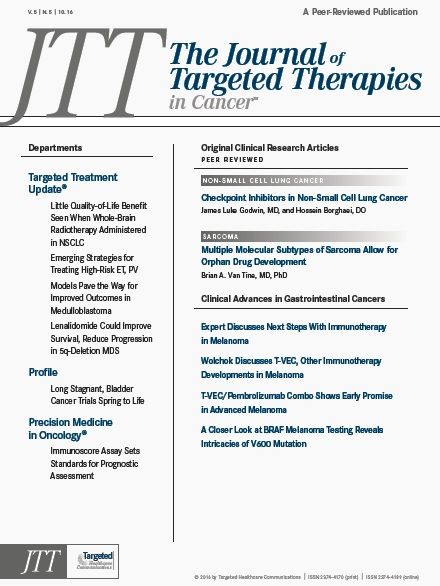Expert Discusses Next Steps With Immunotherapy in Melanoma
In an interview, Yvonne Saenger, MD, discussed ongoing developments with immunotherapy in melanoma.
Yvonne Saenger, MD
Immunotherapy with agents, such as the PD-1 inhibitor nivolumab (Opdivo) and the CTLA-4 inhibitor ipilimumab (Yervoy), has propelled the field of melanoma forward, but researchers are still actively seeking how to optimally use these checkpoint inhibitors.
Specifically, ongoing research is exploring single-agent versus combination use of nivolumab and ipilimumab, as well as the ideal sequencing approach for the 2 drugs. At this point, combination regimens have proven highly effective, says Yvonne Saenger, MD, the director of Melanoma Immunotherapy at Columbia University Medical Center.
“Thus far, it really seems that the more immunotherapy the better. It is likely that the more we pile these agents together, the better response rates we will get,” says Saenger.
In an interview withThe Journal of Targeted Therapies(JTT) during the recent Society for Immunotherapy of Cancer Cancer Immunotherapy 101 meeting in New York City, Saenger discussed ongoing developments with immunotherapy in melanoma.
JTT:Can you discuss your investigational research into biomarkers for immunotherapy?
Saenger:
It is really critical because, even in melanoma, we are only curing a minority of patients. There were data related to antiPD-1, which is probably the most effective immunotherapy in melanoma, and the 5-year survival rate was about 35%. This is incredible, since the 5-year survival rate used to be less than 5%. However, it still illustrates that we have much further to go, especially when you consider other malignancies where the response rates and benefits tend to be less.
We really need biomarkers to assess who is most likely to benefit. One major motivation for developing biomarkers is that, if we understand more about what changes in the tumor and the immune system are associated with benefit, we can begin to understand why people are not responding. We could also understand which types of cells or immune signaling pathways need to be activated in order to get effective immunotherapy.
The research I do in my laboratory focuses on strategies that are applicable to standard clinical samples. We analyze RNA, which is basically gene expression by the immune cells, and we analyze it in the tumor and the blood of patients receiving immunotherapy. In some cases, we also study immune surveillance, which sort of indicates how strong the immune system is at baseline before you even start immunotherapy. We also look at multiplex immunohistochemistry to try to understand how the position and types of immune cells within the tumor may have an impact on how the patient does clinically.
What are your thoughts on sequential or combination therapy with nivolumab and ipilimumab in melanoma?
It seems that the jury is still out on whether the combination of nivolumab and ipilimumab is better than single-agent treatment. We are currently at a place where we need to use some clinical judgment there. If we have a patient who is really progressing rapidly, and, particularly, if they are BRAF wild-type, using the combination would make sense. If you have a patient who is not progressing rapidly, given the absence of overall survival benefit and increased toxicities of the combination, I believe the single-agent approach may be quite reasonable.
I am suspecting we are at a transition point right now, as far as what is FDA approved. As more immunotherapies are approved in melanoma, we will start using more combinations beyond even ipilimumab and nivolumabadding in oncolytic viruses and IDO inhibitors, for example. Then, we will start seeing clear benefits to combination therapy. For now, I believe the minimum requirement is for you to include a PD-1 agent in the first-line setting.
What are the next investigational steps with immunotherapy?
There are 2 really exciting areas right now, one of those being locally targeted therapies. For a long time, we have known about the abscopal effect. This means that when you radiate a lesion, you can generate a systemic immune response and other lesions may respond.
To a certain extent, an extension of that method is talimogene laherparepvec (T-VEC; Imlygic). The concept of directly attacking the tumor immune microenvironment through either injecting a virus or radiation is very exciting, and combining that with a checkpoint blockade will likely yield better results than a checkpoint blockade alone. This is because you can have T cells in the periphery but they don’t always make it into the tumor. Therefore, combining it with a local strategy is going to be very important, especially as we move beyond melanoma into some less immunogenic tumors that have evolved, unfortunately, effective strategies to exclude the T cells from the tumor bed.
Savona Discusses First-Line JAK Inhibition for Patients With Myelofibrosis at Risk of Anemia
April 17th 2024During a Case-Based Roundtable® event, Michael Savona, MD, and participants discussed the case of a patient with myelofibrosis and moderate anemia receiving JAK inhibitor therapy.
Read More
